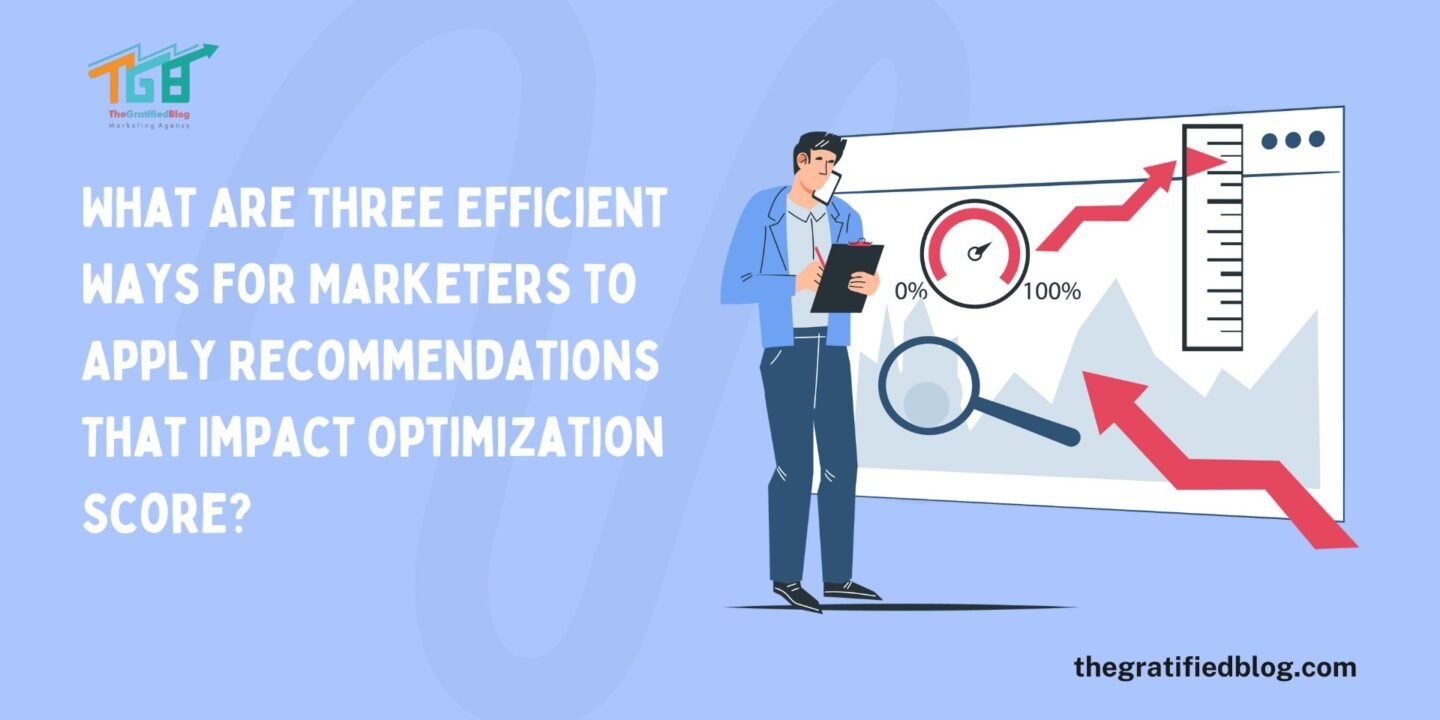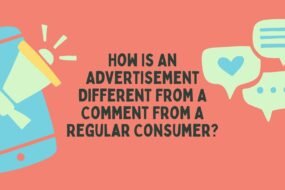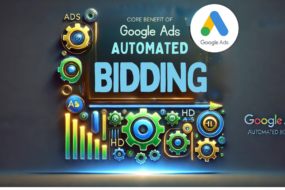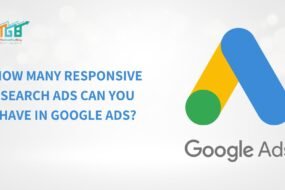
In the fast-paced world of digital marketing, making sure your campaigns are running efficiently is super important. One way marketers can achieve this is by improving their optimization score. But here is the thing: knowing what to do is only half the battle. The real question is, What are three efficient ways for marketers to apply recommendations that impact optimization score?
Let us break it down into three efficient, easy-to-follow strategies that marketers can use to boost their optimization scores and get better results. We will keep it simple and practical so you can start implementing these tips right away. Ready? Let us dive in.
What Is an Optimization Score?
Optimization score is a measure that shows how well your campaign settings align with best practices for driving performance. It is typically shown as a percentage, with 100% meaning your campaigns are fully optimized.
Why Does It Matters?
- Improved Ad Performance: Higher scores often lead to better ad placements and increased click-through rates.
- Cost Efficiency: Optimized campaigns minimize wasted spend on low-quality traffic, maximizing your return on ad spend (ROAS).
- Enhanced Targeting: A good score ensures better audience targeting and engagement.
- Easier Decision-Making: The score identifies areas for improvement, streamlining your campaign adjustments and eliminating guesswork.
What Affects Your Optimization Score?
- Ad Relevance: Are your ads relevant to the keywords and audience you are targeting?
- Bidding Strategies: Are your bids competitive and aligned with your campaign goals?
- Audience Targeting: Are you reaching the right people at the right time?
- Campaign Activity: Are you actively monitoring and updating your campaigns?
How Are Recommendations Related to Optimization Score?
Every recommendation you receive is designed to fix gaps in your campaigns. Some of these gaps could be holding back your performance, while others might help you stay ahead of competitors.
Types of Recommendations You Might See:
- Targeting Adjustments: Suggestions to refine your audience based on demographics or behavior.
- Bidding Strategies: Ideas for improving how much you pay for clicks or conversions.
- Ad Improvements: Suggestions to make your ad copy, headlines, or images more relevant.
- Keyword Recommendations: Tips to choose high-performing keywords for better campaign targeting.
- Landing Page Suggestions: Improve landing pages for higher engagement and conversion rates.
- Budget Optimization: Maximize ad performance by efficiently allocating your campaign budget.
- Campaign Settings: Adjust settings to align with goals and enhance overall campaign effectiveness.
- Competitor Insights: Analyze competitors to refine strategies and gain a competitive edge.
What Are Three Efficient Ways for Marketers to Apply Recommendations That Impact Optimization Score
To efficiently apply recommendations that positively impact an optimization score, marketers can use these three strategies:
1. Prioritize High-Impact Recommendations
Not all recommendations are created equal. Some will make a big difference, while others may only tweak things here and there. The trick is to focus on the suggestions that will have the most impact on your campaign’s performance.
How to Identify High-Impact Recommendations:
- Check Performance Metrics: Look at which recommendations are tied to critical areas like click-through rate, conversion rate, or cost-per-click.
- Focus on Relevance: Ignore generic suggestions that do not align with your campaign goals. For instance, if your goal is to drive sales, prioritize recommendations about bidding strategies or ad targeting.
- Use a Traffic Light Approach: Imagine your recommendations are traffic lights. Green means “high priority,” yellow means “moderate impact,” and red means “low priority.” Start with the greens.
Examples of High-Impact Recommendations:
- Enabling automated bidding for better ad placement.
- Adding negative keywords to prevent wasted spend.
- Improving ad relevance by rewriting headlines or descriptions.
Why This Works:
Focusing on high-impact tasks saves you time and energy. Instead of spreading yourself thin across every suggestion, you channel your effort into the changes that really matter.
2. Embrace Automation to Save Time
Manually managing campaigns can feel like a never-ending to-do list. This is where automation becomes your best friend. Many platforms, like Google Ads, offer automated tools that can help you implement recommendations faster and more accurately.
Steps to Use Automation Effectively:
- Enable Smart Bidding: Let the platform decide your bids based on real-time data, like user behavior and device type.
- Set Up Automated Rules: Create rules for when to pause underperforming ads, increase budgets, or adjust bids.
- Use Responsive Ads: These automatically test different combinations of headlines and descriptions to find what works best.
Benefits of Automation:
- Saves Time: You can focus on strategy while automation handles repetitive tasks.
- Reduces Errors: Automation tools work with precision, minimizing mistakes.
- Improves Results: Automated systems analyze tons of data to make smarter decisions than we can manage manually.
Quick Tip:
Start small with automation. Test one or two features, like Smart Bidding or responsive search ads, and track their performance before diving into more complex tools.
3. Regularly Review and Update Campaigns
Here is the thing about optimization: it is not a one-and-done deal. Markets shift, user behaviors change, and what worked yesterday might not work tomorrow. That is why it is so important to review your campaigns regularly and keep them updated.
How to Keep Campaigns Fresh:
- Schedule Weekly Check-Ins: Set aside time every week to review performance metrics and optimization scores.
- Test New Ideas: Experiment with different ad formats, images, or call-to-action phrases to see what clicks with your audience.
- Monitor Competitors: Keep an eye on what your competitors are doing. It might inspire tweaks to your own strategy.
- Use Seasonal Trends: Adjust your campaigns for holidays, events, or seasonal demand. For example, focus on Christmas-related keywords in December.
Signs It Is Time to Update Your Campaign:
- Performance metrics have plateaued or dropped.
- Your target audience has changed, like shifting demographics or interests.
- There are new features or tools on the platform you are using.
Why Regular Updates Matter:
Keeping your campaigns updated ensures they stay relevant and effective. Plus, platforms often reward active accounts with better ad placements and lower costs.
How Can Marketers Predict the Impact of Applying Recommendations on Their Optimization Score?
Predicting the impact can guide you to prioritize tasks that deliver the best results:
Steps to Predict the Impact:
- Understand the Weight of Recommendations: Each suggestion often has a specific weight in improving your score. High-impact recommendations like enabling automated bidding or improving ad relevance typically carry more weight than minor tweaks.
- Analyze Past Campaigns: Look at the results of similar recommendations applied before. Did they improve key performance indicators? If yes, they might have a significant impact on your current campaigns too.
- Use Simulations: Some platforms provide tools to simulate the effects of applying recommendations. This can give you an idea of how much your score could improve.
What to Look For:
- Recommendations that directly address major issues in your campaign, like ad relevance or targeting.
- Suggestions that align with your campaign goals, such as increasing conversions or reducing cost-per-click.
- Changes that fix underperforming areas, like ads with low click-through rates or high bounce rates.
Why Prediction Matters:
By predicting the impact, you can make informed decisions about which recommendations to tackle first. This saves time and ensures that your efforts are focused on changes that truly matter.
What Are the Common Challenges When Applying Recommendations?
Even though recommendations are helpful, applying them can sometimes feel tricky. Here are some challenges marketers face and how to overcome them:
Challenge 1: Too Many Recommendations
Solution: Filter out low-priority suggestions and focus on high-impact ones.
Challenge 2: Limited Budget
Solution: Allocate your budget to the changes that promise the highest ROI.
Challenge 3: Lack of Understanding
Solution: Research or consult experts to clarify the purpose and expected outcomes of a recommendation.
Challenge 4: Resistance from Team Members
Solution: Involve the team early, explain the benefits, and address concerns collaboratively.
Challenge 5: Difficulty Measuring Impact
Solution: Use clear KPIs and analytics tools to track and quantify the results of implemented recommendations.
Challenge 6: Limited Time
Solution: Prioritize quick wins and schedule more complex changes for later phases.
Challenge 7: Inadequate Tools or Technology
Solution: Invest in scalable tools or leverage free alternatives to support implementation effectively.
What Are the Pro Tips for Staying Ahead?
Here are some additional ideas to help you get the most out of your recommendations and boost that optimization score:
- Use Analytics: Dive into your data to see what is working and what is not. Numbers tell a story—listen to it.
- Ask for Help: If you are unsure about a recommendation, reach out to a colleague or a community group. Fresh perspectives can do wonders.
- Stay Curious: Digital marketing evolves fast. Make it a habit to learn about new tools and strategies.
- Test Regularly: Experiment with A/B testing to find what resonates best with your audience.
- Keep It Simple: Prioritize recommendations that align with your goals for quick and effective implementation.
- Leverage Automation: Use automation tools to streamline repetitive tasks and focus on high-impact strategies.
- Review Competitors: Analyze what competitors are doing well and identify areas to differentiate your approach.
Frequently Asked Questions
Q1. What Are Three Efficient Ways for Marketers to Apply Recommendations That Impact Optimization Score?
Ans. Marketers can efficiently apply recommendations by prioritizing high-impact changes that improve performance, leveraging automation tools like Smart Bidding to save time, and regularly reviewing and updating campaigns to keep them fresh and relevant. These steps ensure smarter allocation of resources and better alignment with campaign goals.
Q2. How Can Marketers Predict the Impact of Applying Recommendations on Their Optimization Score?
Ans. Marketers can predict the impact by analyzing past performance, using simulations provided by platforms, and understanding the weight of each recommendation. High-priority recommendations that address major issues like ad relevance or bidding typically have the most significant effect on optimization scores.
Q3. What Are Two Ways an Optimization Score Can Help Marketers Succeed?
Ans. First, a higher optimization score improves ad placement, leading to better visibility and engagement. Second, it helps reduce wasted spending by highlighting ineffective areas of a campaign, ensuring marketers focus on strategies that deliver maximum returns.
Q4. How Can the Optimization Score Be Used to Help Increase Effectiveness?
Ans. Optimization scores guide marketers to make data-driven decisions by highlighting actionable recommendations. Implementing these suggestions improves targeting, bidding, and ad quality, resulting in more efficient campaigns and better alignment with audience needs and business goals.
Q5. What Determines Whether or Not an Optimization Score Recommendation Appears for a Particular Account?
Ans. Recommendations appear based on an account’s settings, performance metrics, and campaign goals. Factors like ad relevance, bidding strategies, and audience targeting determine which recommendations are shown, ensuring they are tailored to address the specific needs of each account.
Wrapping Up
Improving your optimization score does not have to feel overwhelming. By focusing on high-impact recommendations, embracing automation, and keeping your campaigns fresh, you can make meaningful changes without burning out.
The best part? These strategies are not just about getting a better score. They are about driving real results for your business—whether that is more clicks, more conversions, or a better return on your ad spend.
So, take these tips, put them into action, and watch your campaigns perform better than ever. Happy optimizing!








No Comments